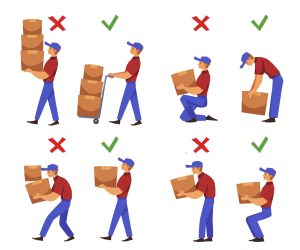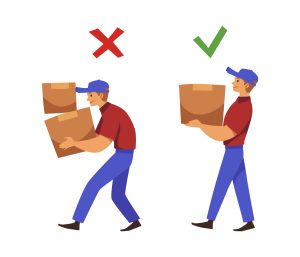Have you suffered an injury because you were given no manual handling training at work? If this is the case, you may be eligible to make a personal injury claim against your employer for a manual handling injury.
Your employer is legally obligated to provide training if it is needed to carry out work duties safely. Should they not do so and you suffer an injury, you might be entitled to compensation. However, all personal injury claims must meet certain eligibility criteria. We explain these and then look at how you can prove you satisfy the requirements.
If you decide to file a personal injury claim against your employer, you may like to know how your compensation could be awarded. We look at what factors affect personal injury settlements.
Should you wish to pursue a manual handling claim, you may like to have a solicitor to help you through the process. We conclude this guide by looking at the benefits of having the support of a personal injury solicitor on a No Win No Fee basis.
If you have any questions about making a personal injury claim for a manual handling accident, speak to one of the advisors from our team.
To discuss injuries caused by a lack of manual handling training:
- Call 020 8050 2736
- Fill in our claim online form for a call back.
- Ask about manual handling claims in our live chat.
Select A Section
- Can You Claim If You Were Given No Manual Handling Training At Work?
- How To Claim If Injured By No Manual Handling Training At Work
- What Should Manual Handling Training Consist Of?
- How Much Compensation For A Manual Handling Injury?
- Why Claim Personal Injury Compensation On A No Win No Fee Basis?
- Read More About Claiming After Receiving No Training At Work
Can You Claim If You Were Given No Manual Handling Training At Work?
You might be eligible to claim compensation if you suffered an injury because of no manual handling training at work. This is because your employer owes you a duty of care while you are performing work-related duties.
As per the Health and Safety at Work etc. Act 1974 (HASAWA), an employer needs to take reasonably practicable steps to protect the health, safety and welfare of their employees. HAWASA is the main health and safety legislation for workplace safety. However, in this case the employer would also need to adhere to the Manual Handling Operations Regulations 1992.
These regulations require risk assessments before conducting a manual handling operation. If the risk assessment identifies ways the task could be made safer and it is reasonably practicable to do so, these steps should be taken.
However, if you would like to make a personal injury claim against your employer for an accident at work, you need to prove that:
- Your employer owed a duty of care.
- A breach of this duty occurred.
- This breach caused your injury.
An advisor can further discuss manual handling claims and assess whether you have good grounds to launch one.
How To Claim If Injured By No Manual Handling Training At Work
As part of the personal injury claims process, you will need to have compelling evidence that proves liability for your injuries. A few examples of items that could be useful to submit for an accident at work claim includes:
- Accident videos. For example, you can request CCTV footage of yourself.
- Witness contact details. If you note contact information from anyone who saw what happened, they can give witness statements later on in the process.
- Photographs. For example, if the lifting aids that were required to move an item safely were broken, you can submit pictures of this.
- Medical records. If you sought treatment following your injuries, your medical records can illustrate the nature of these.
- Accident book. An accident book is a legal requirement for any workplace with ten or more staff members. It should be filled out with your name, time and date, and details of the accident.
If you have any questions about how you can prove that no manual handling training at work resulted in your injuries, consult one of our advisors.
What Should Manual Handling Training Consist Of?
By the Health and Safety Executive’s (HSE) definition, manual handling means using hand or bodily force to transport or support a load. Manual handling operations include:
- Lifting
- Putting down
- Pushing
- Pulling
- Carrying
- Moving.
The HSE regulates and monitors health and safety in the workplace.
The exact manual handling training you should have will vary depending on the nature of your job and the items that require handling. However, your employer needs to provide it, if it is needed to do your job safely and to comply with health and safety legislation. Training should also be tailored to the employee.
The HSE states that training should cover:
- Risk factors of the task and how injuries could occur.
- How to use mechanical aids (if relevant).
- Good handling techniques.
- Work systems that are relevant to the tasks and environment.
- Practical work and assessment so the trainer can identify improper manual handling techniques and put them right.
How Could You Be Injured By A Lack Of Manual Handling Training?
You could suffer various injuries due to no manual handling training at work. These include:
- Brain injury because an object fell on you due to being stacked incorrectly.
- Back injury due to no training on lifting techniques.
- Shoulder injury because the object was too heavy for one person.
- Toe and foot injuries because the object was dropped due to being too heavy for one person to carry.
- Finger injury due to fingers becoming trapped, such as in a faulty roll cage.
- Soft tissue injuries because of stretching for an object above shoulder height.
How Much Compensation For A Manual Handling Injury?
If you make a successful claim for a manual handling injury at work, your settlement could consist of two parts. These are general and special damages.
Under general damages, successful claimants are compensated for the physical damage and mental suffering that has been caused. Those responsible for valuing accident at work claims may refer to the guideline compensation amounts published by the Judicial College (JCG) to help them assign value to injuries.
In the top row, we look at how you could be compensated for more than one serious injury and incurred costs. The amount in the top row is not part of the JCG. The following rows look at guideline compensation amounts from the 16th edition of the JCG for injuries that could occur due to no manual handling training at work. As all claims are different, the table is only a guide.
Injury Severity Notes Compensation Guideline
Multiple Severe Injuries and Related Costs Very Severe Compensation can be awarded for multiple injuries and expenses, including lost wages and care. Up to £250,000+
Back Injury Severe (i) These injuries cause severe pain and disability, such as impairments the functioning of the bowel and bladder and incomplete paralysis. £91,090 to £160,980
Back Injury Moderate (ii) This bracket includes many frequently encountered injuries that cause back pain with the award decided by the person's ability to engage in daily life and prognosis. £12,510 to £27,760
Brain Injury Moderate (ii) Injured parties suffer from a moderate to modest intellectual deficit with some epilepsy risk and a reduced or removed work ability. £90,720 to £150,110
Hand Injury Total/Effective Loss of One Hand The hand may have been crushed and amputated or most of the palm and all the fingers were lost. £96,160 to £109,650
Hand Injury Serious In these cases, the hand has lost 50% of its capacity. £29,000 to £61,910
Finger Injury Middle, Index and/or Ring Finger Amputations The hand is of very little use due to these amputations. £61,910 to £90,750
Foot Injury Serious The claimant suffers continuing pain from arthritis or the risk of arthritis in the future, prolonged treatment and fusion surgery risk. £24,990 to £39,200
Toe Injury Severe Injuries in this bracket include severe crush injuries that result in one or two toes being amputated or partially amputated. £13,740 to £21,070
Shoulder Injury Serious The claimant suffers pain in the shoulder and neck, sensory problems in forearm and hand and grip weakness due to damage to the lower brachial plexus. £12,770 to £19,200
Why Claim Personal Injury Compensation On A No Win No Fee Basis?
If you are eligible to seek compensation for injuries suffered due to no manual handling training at work, you may wish to have a solicitor to help with the claim procedure. One of the personal injury solicitors from our panel could support your claim on a No Win No Fee basis. They generally use a Conditional Fee Agreement (CFA) to offer their No Win No Fee services.
This means that your solicitor:
- Won’t ask you to pay upfront costs for their services.
- Ask you for ongoing payments.
- Charge you if your manual handling injury claim fails.
- Will only take a legally capped percentage of your award, known as a success fee, if your claim succeeds.
If you have any questions or would like to find out if you are eligible to claim for injuries sustained because your employer failed to provide manual handling training, please speak with an advisor. If your claim has good grounds, you could be connected to one of the solicitors from our panel.
To discuss manual handling injury claims:
- Call 020 8050 2736
- Fill in our claim online form and an advisor will call you.
- Ask about starting a compensation claim in our live chat.
Read More About Claiming After Receiving No Training At Work
Further guides about accidents at work claims:
- Information about personal injury claims for a serious work injury and how much compensation could be awarded.
- Guidance about broken work equipment and whether you can claim compensation.
- Top tips on how to prevent an accident at work.
External resources you may find helpful:
- Guidance on health and safety for employees from the HSE.
- Information about statutory sick pay, including rates and how to apply from the government.
- Details about how to perform first aid from the NHS.
If you need any further information about claiming for injuries sustained due to no manual handling training at work, speak with one of our team members.




